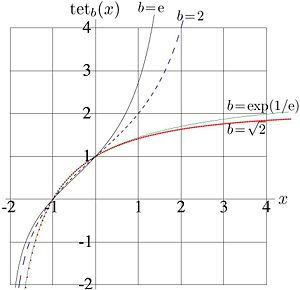Tetration: Difference between revisions
imported>Dmitrii Kouznetsov (add pic) |
imported>Dmitrii Kouznetsov |
||
| Line 7: | Line 7: | ||
<math>x</math>.]] | <math>x</math>.]] | ||
This article is currently [[under construction]]. While, use article from wikipedia http://en.wikipedia.org/wiki/Tetration | This article is currently [[under construction]]. While, use article from wikipedia http://en.wikipedia.org/wiki/Tetration | ||
== | ==Definiton== | ||
For real <math>b>1</math>, Tetration <math>F=\mathrm{tet}_b</math> on the base <math>b</math> is function of complex variable, which is [[holomorphic]] at least in the range | |||
<math> \{ z \in \mathbb{C} :~ \Re(z) > -2 \}</math>, bounded in the range | |||
<math> \{ z \in \mathbb{C} :~ |\Re(z)| \le 1 \}</math>, and satisfies conditions | |||
: <math> F(z+1) = \exp_b\! \big( F(z) \big) </math> | |||
: <math> F(0) = 1 </math> | |||
: <math> F\!\big(z^*\big) = F\big(z\big)^*</math> | |||
at least within range <math> \Re(z)>-2 </math>. | |||
==Real values of the arguments== | |||
Examples of behavior of this function at the real axis are shown in figure 1 for values | |||
<math>b=\mathrm{e}</math>, | |||
<math>b=2</math>, | |||
<math>b=\exp(1/\mathrm{e})</math>, and for | |||
<math>b=\sqrt{2}</math>. It has logarithmic singularity at <math>-2</math>, and it is monotonously increasing function. | |||
At <math>b\le \exp(1/\mathrm{e})</math> tetration <math>\mathrm{tet}_b(x)</math> approaches its limiting value as | |||
<math>x\rightarrow +\infty</math>, and <math>\displaystyle \lim_{x \rightarrow +\infty} ~ \mathrm{tet}_b(x) > 1</math>. | |||
At <math>b > \exp(1/\mathrm{e})</math> tetration <math>\mathrm{tet}_b(x)</math> grows faster than any exponential function. For this reason the tetration is suggested for the representation of huge numbers in [[mathematics of computation]]. | |||
A number, that cannot be stored as [[floating point]], could be stored as <math>\mathrm{tet}_b(x)</math> for some standard value of <math>b</math> (for example, <math>b=2</math> or <math>b=\mathrm{e}</math>) and relatively moderate value of <math>x</math>. The analytic properties of tetration could be used for the implementation of arithmetic operations without to convert numbers to the floating point representation. | |||
==Integer values of the argument== | |||
For integer <math>z</math>, tetration | |||
: <math>{\rm tet}_b</math> | |||
==Etymology== | ==Etymology== | ||
Revision as of 06:34, 29 October 2008
This article is currently under construction. While, use article from wikipedia http://en.wikipedia.org/wiki/Tetration
Definiton
For real , Tetration on the base is function of complex variable, which is holomorphic at least in the range , bounded in the range , and satisfies conditions
at least within range .
Real values of the arguments
Examples of behavior of this function at the real axis are shown in figure 1 for values , , , and for . It has logarithmic singularity at , and it is monotonously increasing function.
At tetration approaches its limiting value as , and .
At tetration grows faster than any exponential function. For this reason the tetration is suggested for the representation of huge numbers in mathematics of computation. A number, that cannot be stored as floating point, could be stored as for some standard value of (for example, or ) and relatively moderate value of . The analytic properties of tetration could be used for the implementation of arithmetic operations without to convert numbers to the floating point representation.
Integer values of the argument
For integer , tetration
Etymology
Creation of word tetration is attributed to Englidh mathematician Reuben Louis Goodstein [1] [2].
Piecewice tetration
uxp
Analytic tetration
This section is not yet written. There is non-finished draft at User:Dmitrii Kouznetsov/Analytic Tetration.
Inverse of tetration
See also
References
- ↑ "TETRATION, a term for repeated exponentiation, was introduced by Reuben Louis Goodstein". Earliest Known Uses of Some of the Words of Mathematics, http://members.aol.com/jeff570/t.html
- ↑ R.L.Goodstein (1947). "Transfinite ordinals in recursive number theory". Journal of Symbolic Logic 12.
Free online sources
- http://reglos.de/lars/ffx.html , Lars Kindermann. References about Iterative Roots and Fractional Iteration.
- http://math.eretrandre.org/tetrationforum/index.php , Discussion about tetration
- http://tetration.itgo.com/ Tetration site by Andrew Robbins
- http://www.tetration.org/ Tetration site by Daniel Geisler






















